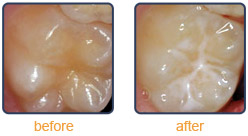Pits and fissures found on our teeth are obvious stagnation areas where dental plaque can form and mature, which will then lead to dental cavities forming at the entrance to the fissures on teeth. The tooth is most susceptible to plaque stagnation when it first erupts into the mouth because at this time the chewing surface is below the normal line compared to the other teeth and can be easily missed during tooth brushing. Therefore susceptible fissures where good oral hygiene is not established should be protected with a dental tooth sealant. Continue reading
Tag Archives: dental cavities
Preventing Dental Cavities with Sugar Substitutes
To most people the term sugar refers to the common household foodstuff table sugar (sucrose). Yet sucrose is only one of many naturally occurring sugars used in the human diet. Technically the term sugar applies to two classifications of carbohydrates. Free-form monosaccharides (simple sugars) include the more common glucose, fructose, and galactose. Disaccharides (two simple sugar molecules linked together) include the most common sucrose, lactose, and maltose. Naturally occurring sugars are available in fruits, vegetables, grains and dairy foods. Sweeteners are added sugars that are used as ingredients to both satisfy our taste and in some cases provide added energy. Continue reading
Preventing Dental Cavities by Avoiding Sweets
Sweets are a bane to our teeth. Not only do they cause cavities in our mouth, they could also be detrimental to our health if consumed in large amounts. Teeth cavities (also known as dental caries in dental terms) is a common plaque-dependent bacterial infection that is strongly affected by diet. Continue reading
Your Guide To Preventing Cavities
Cavities in teeth or tooth decay, also known as dental caries to the dental community, is a process that may take place on any tooth surface in the mouth where dental plaque is allowed to develop over a period of time.
Cavities will not only cause you pain in your mouth but also a hole in your wallet if you let the decay progress further as a more extensive dental treatment would be required to treat something that could have been prevented earlier on. Continue reading



